#elite gold trader
Text
Suina- ‘Swine of the Nether and Overworld’

Suina— Those of the pig or pig-like grouping
The swine of the Nether and overworld are some of the most curious species seen within minecraft severs, for while the overworld pig itself is often considered with little thought or interest, their lineage has found a notable root within the Nether dimension.
Thought to either derive from a shared ancestor with the modern overworld pig or to be direct descendants from overworld pigs, the Nether piglins and hoglins are a result of prehistoric Suina being transferred from the overworld into the harsh climate of the Nether dimension. Dimensional travel is known to have occurred several times in the past either to transfer varying civilizations across dimensions to traveling of varying species, etc., allowing for a great change in the affected species when they find an environment open for colonization and adaption.
However, the history of these species, particularly of the piglin are currently clouded in mystery, as even the piglin race itself seems to be struggling to reclaim not only a damaged culture, but a species that had been plagued by a deadly disease.
When first encountered, most players knew of the piglins as ‘the pigmen’ particularly as the ‘zombie pigmen’ for that was of the limited showcasing seen of this race and species for some time.
Zombie pigmen (not showcased as they are simply piglin that have fallen victim to a ‘zombie’ infection like what can be observed in the overworld, though overworld zombies are a curious endeavor in themselves and shall be discussed in the future as well as their possible lead into the hypothesis of the lost civilizations of the past) were initially noted for being tuskless, blank eyed, and for the most part, harmless unless one of their groups were attacked.
They offered what was thought to be the only evidence of an extinct swine race with ancient fortress further solidifying this lost intelligence, however, this would be proven to be false when contact was made with unaffected piglin. These piglin seem to have been either in hiding or living within underground systems, though these exact settlements have been yet to be found by or shown to players.
Either way, piglins themsleves can showcase curious variance. Piglin are noted as follows; common, brutes, and proto.
Common piglin are the most often noted piglin after the society’s re-emergence to the Nether surface, tusk shapes and tusk sizes varying from differing families and areas, fur showcasing differing colors though most commonly ranging from dark maroons to pale pinks, and all having odd pale eyes. They hold a very guarded view of their hunting or roaming grounds though they will overlook those that wear gold or can be bribed for safe passage with gold ingots (which they will readily accept for trades of any knick-knacks they may be carrying with themsleves at the time of trade).
Brute piglin are the second most common piglin groups and the most deadly of this group, though they are not another species or subtype and rather are an elite class of common piglin. They often train throughout childhood to best excel at direct fighting, using axes often as their choice of weapon, often differentiated from other more casual traders or hunters or explorers due to their specialized armor and noted eye-scars. All brutes, when they’ve finished their training as brutes, will be ceremonial marked with a blade over their left eye.
Brutes will be commonly found guarding fortresses believed to be either sacred areas or remnants of their race’s ancient civilization (whichever it turns out to be, all that should be noted is these areas will be defended to the death and hoard notable treasure troves within their dark armored walls).
Finally there is the tuskless piglin, or the original ‘pigmen.’ They are one of the rarest variant and unlike the brute or common, they lack tusks and often have darker eyes than the pale gazes seen on other piglins. They however, are also one of the most peaceful, seeming to be almost outcasts as they will rarely wear gold themselves and tend to be found more isolated than others in their journeying.
It is thought that they are some of the last ‘pure-blooded’ piglins left, the tusked variety actually being descended from those that had been infected with the deadly disease but instead of rotting away, seemed unaffected majorly. However, their pale eyes is what gives credit to this, for only those piglin infected have pale eyes and it seems as though while the ancient disease itself has either been overcome or became unable to further infect its hosts, remainders of the causer of this disease’s DNA remains through the generations, producing these pale eyes into the modern age as a byproduct of this ancient infection.
It’s unknown why the tuskless piglin and tusked piglin refuse to interact with one another, but it may have been due to some groups hiding away from anyone of their civilization that showcases even a possibilty of being infectious and when the groups re-emerged they had unintentionally changed so greatly from one another that cultural clashes and differences prevent effective remingling.
While I could go into the possible theories into what exactly this infection was (my personal theory involves the odd fungus seen within the Nether), I will save that tangent for another time and instead bring up the other curious species of swine in the Nether: the hoglin.
Hoglin, unlike piglin, are not so much a sentient race but rather feared predators that came back around the re-emergence of the piglins. The two races have a great rivalry between them and will readily hunt the other (though young of both species will intermingle and have been seen playing with one another until encountering one of the parties pissed off parents).
Hoglins themselves rely heavily on scent and hearing for they are nearly completely blind (though it is doubted that this is because of the ancient disease that killed off a majority of the piglin race and rather a result of increased use of scent and hearing and the eyes being practically useless with heavy smoke and sulfur in the air), ramming anything they believe to be food with their massive and muscular heads to gorge them on its sharp, forward curving tusks.
They are incredible deadly and territorial and it is often a mass celebration by piglins when witnessing the death of one of these creatures. Notable elsewise is that unlike the bipedal piglin, the hoglin remains quadpedal like its kin, the overworld pig. They however have very large and spread out feet rather than the more precise footing of the overworld pig, as they travel far distances to find food and often travel harsh distances across rough terrain.
Overall, Suina are a facsianting example of how easily organisms will thrive when given an opportunity. Possibly their ancestors came from the overworld following hexapod migrations into these areas, or perhaps they were leftovers from traveling past civilizations that spawned their own development and societies.
Perhaps the fortresses and strongholds noted today aren’t even of piglin construction and could infact be evidence of the lost civilizations that fled the overworld so many millennia ago, either way, the more we look into these races and species, the more opportunity we have to learn about the past of these varying dimensions.
#my art#traditional art#minecraft#minecraft speculative biology#speculative biology#minecraft mobs#piglin#pigmen#hoglin#minecraft pig#minecraft biology#My deisgns
65 notes
·
View notes
Text
IBO reference notes on . . . the battle at the low-orbit station
So. According to Gundam Wiki (citing an official Twitter message that's cited in turn without a link on an English-language message board), the shoulder-mounted bazooka that Akihiro uses in his second deployment in the Graze Custom was acquired during the battle in Mars orbit that forms the bulk episode 5, 'Beyond the Red Sky', when Tekkadan manage to run rings around Colonel Coral Conrad and shady trader Orcus (remember Orcus?). This struck me as rather curious, since I couldn't remember a point in that fight where it would have made sense for anybody to mug a Graze for its weaponry, much less a bazooka-equipped Graze actually appearing among the Gjallarhorn forces.
Being a diligent sort of obsessive, I decided to go back and watch the episode in full, to check my memory. This led to noting a number of (to me) interesting things and since nobody can stop me, I'm going to jot them down here.
First up, the Graze contingent for this episode mostly consists of the rather nice blue models labelled alternatively in secondary material as the 'Ares type' or 'space type'. The latter seems the most useful term since we see this livery repeat at various other locations later on, most significantly as part of the Dort Colony garrison and Gaelio's intercept squadron in Earth orbit. We can assume this is the general-purpose colours for Gjallarhorn 'suits operating in space, outside of elite units like the Arianrhod Fleet or those under the Seven Stars direct control (e.g. the yellow/gold versions the Issues use in Urdr Hunt).
Like a lot of the Graze's design, this seems to be a callback to the Leos from Gundam Wing, which featured a similar green/indigo distinction for ground/space (although space Leos are much more purple).


This episode is the series' first major space battle and it showcases some brilliant shot composition. There's so much to love about how this fight is story-boarded, from the mobile suits flying at weird angles to one another, to the way in-cockpit views are used.
The right-hand image here is from the perspective of Ein Dalton's Graze, and his appearance demonstrates a small detail that's easy to miss if you haven't poured over the the concept art. While this is still the green Graze that Ein was piloting in the opening episodes (its arm having been replaced in the meantime), the waist-mounted boosters have been swapped for blue shoulder-mounted units, like the rest of the squadron deployed from the Ares space station.
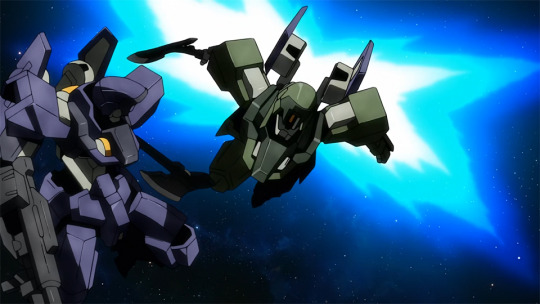
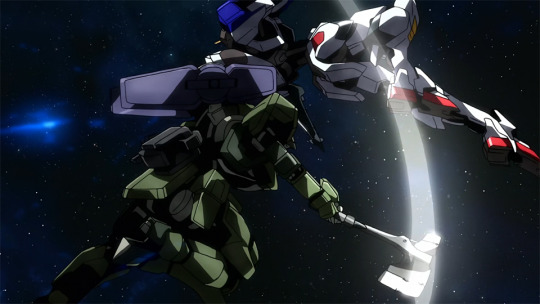
This is because the space boosters are slightly different from the ground-use ones, featuring extra vernier jets. However, I'm not sure the gaps for those ought to have been drawn in the left screenshot here, since they're supposed to be at right angles to the main thrusters. You can see the correct rendering on the left, below. In a great bit of continuity, Ein is later shown assisting this particular Graze after it's lost one of its boosters. Good boy! (For all that he turned out to be a mite unbalanced, Ein begins as a very diligent soldier.)


Oddly enough given its ubiquity in the merchandising, the shot on the right will be the last time the green Mars-branch Graze is seen in action in the show. After this, Ein switches to using Gaelio's Schwalbe Graze, and opposition to Tekkadan comes from different Gjallarhorn units using other colour schemes. The Arianrhod Grazes that will become the mandated 'green enemy type' for Season 2 are a notably different shade and colour layout (left), and the next and final time the 'Mars green' Graze appears, it will be in the rather ignoble aftermath of Hashmal's rampage across the Chryse Planatia (right).
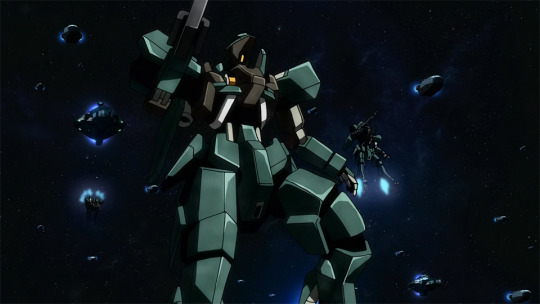
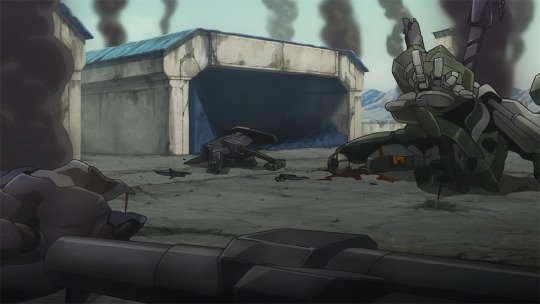
[EDIT: I belatedly realised the above is not quite true: Mars-green Grazes do in fact participate in the final battle of the show against Mikazuki and Akihiro, and the machine Iok commandeers after McGillis wrecks his custom model is painted in these colours. So that's actually a nice bookending. I was misremembering because most of the action is handled by the Graze Schild variants.]
Anyway, that's enough Graze appreciation.
Time for some blatant Eugene Sevenstark propaganda.

Up to this point in the show, Eugene has been positioned as something between a joke character and the obligatory Doubting Thomas. He's clearly got an ego, clearly has a chip on his shoulder regarding Orga's leadership, and his main contribution to a battle previously has been to run away (very effectively, saving Orga's life in the process, but still).
Then, with Gjallarhorn and Orcus bearing down on Tekkadan's spacehsip, Orga comes up with a plan to use a nearby mining asteroid to perform an insanely sharp handbrake turn in order to gain altitude over their pursuers. This involves launching an anchor into the asteroid and sling-shotting the Isaribi through a tight orbit before using an explosive charge to blow the anchor and release them. Given the speed with which this must be enacted, the charge has to be placed manually, using a mobile worker. Orga originally intends to do this himself but Eugene brashly volunteers in his place, saying that as leader, he shouldn't be doing everything himself and grumbling that the others let Orga have his way far too easily.
Both these will be important charaterisation for later.
What I want to talk about, however, is how this manoeuvre goes off. It starts reasonably enough, with the anchor being fired into the rock and Eugene racing down the cable to, uh, shoulder-barge the bomb into position.

He shoots the charge and it detonates, but the anchor struck deeper than expected and doesn't come free. Now, based on past expectations, one might expect Eugene to panic over this. He's certainly not seemed especially level-headed up to now, and perhaps even a bit of a paper-tiger.
Instead, he backflips the mobile worker to launch his fuel tank at the recalcitrant anchor.

I just -- this is the first time we have seen any of these boys operating in space and he just . . . does that. Split second decision-making, zero-g environment, no problem. And it works! The extra blast from the tank frees the anchor.

It's brilliantly rendered too, with Eugene's shots going wide for a long few seconds before he finally gets the range and blows the tank.
If that wasn't enough, we then get a moment of 'oh shit, what happened to Eugene?' as the screen whites out, the cable snaking in silhouette, before coming around again to show that he's managed to latch on to the anchor to ride it back to the Isaribi.

Not only is this a fantastic action sequence, showcasing the weight and physical interaction that IBO excels at, and not only does it cement Eugene's position as 'the guy you really want flying your spaceship', it also serves as excellent set-up for where his griping about Orga's leadership is eventually going to go. Because yes, Eugene complains about Orga charging ahead and raises some legitimate objections. But at the same time, he is fully prepared to take incredibly risky actions on Orga's say-so, both recognising the strategy is sound and trusting Orga enough to follow his lead regardless of personal friction.
This will pay off later in perhaps the worst way it could, when Eugene proves incapable of properly pulling Orga up on his 'I must do everything' tendencies until it's much too late, precisely because of this trust. For now, it's just a wonderful piece of showing-against-telling, highlighting that Eugene is a true part of the team -- whatever he says -- and a damn skilled one at that.
Also, and this is me stretching for interesting reads, but the fact he is *this* good in a mobile worker and in zero-g in general despite being canonically not great during ground battles or when using mobile suits is something I place in the 'neurodivergent Eugene' column. I mean, if that's the right term when we're talking about fighting ability using a human/machine interface. Basically I think there's the basis to argue Eugene just copes better in space, where he can move any way he wants, rather than being stuck under gravity and following a human template. Partly this is inspired by how he gallops his mobile worker during the battle at the CGS base, as if he's trying to jump into the air to escape Orlis Stenja's attempt to kill him and Orga. Mostly, it's this scene, and what it shows us about Eugene's skill level once the gang gets off the ground.
What was I supposed to be talking about?
Oh right, Tekkadan swiping Gjallarhorn components. Well, this episode does give us the Saga of the Schwalbe Cables, as McGillis and Gaelio use their souped-up Grazes against Barbatos and its newly painted shoulders (those are bits of Orlis' Graze. RIP).
McGillis manages to snag Mikazuki's forearm quite soundly, forcing Mika to eject the armour from the frame to make his escape. Bye-bye weirdly out-of-place buckler.

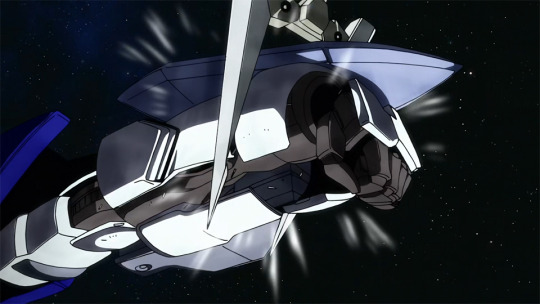
This tussle between the two pilots prompts the beginning of their mutual respect in combat, as they each recognise the other's skill (with some lovely framing to boot).
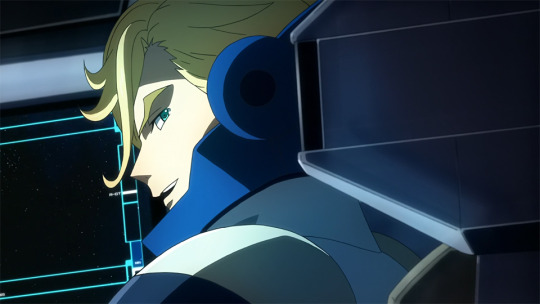
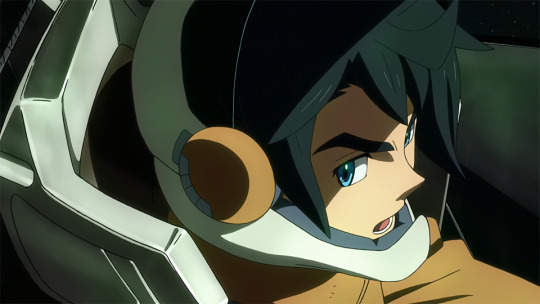
Meanwhile, Gaelio shouts a lot and generally makes a right nit of himself, also latching on to Barbatos and even making a good try at dragging it on to a lower orbit, before getting maced for his efforts.
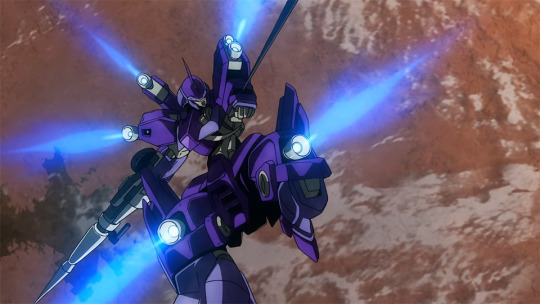

His grappling cable remains latched to Barbatos' leg afterwards and Mika will later use this self-same claw weapon during the fight with the Turbines in a couple of episodes' time.

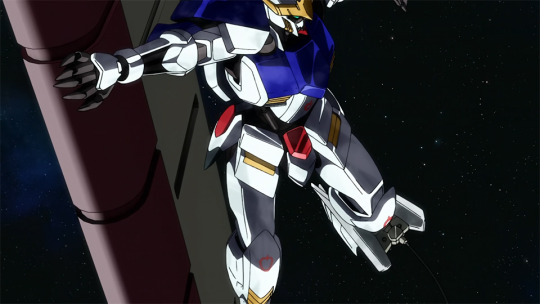
There is a slight animation snafu here, in that while the gauntlet from which the cable is launched is clearly still attached in the shot where we see Mika's mace hit Gaelio's Schwalbe Graze, it's missing from subsequent frames showing Barbatos on the Isaribi's tail. However, the intention is obviously supposed to be that the gauntlet remains connected, since it will replace the ejected forearm armour and be used to allow Mika to keep pace with Lafter's Hyakuri. This glitch aside, the connecting logic is extremely clear, as Tekkadan once more incorporate battlefield debris in place of missing parts of Barbatos' outer shell.
Speaking of continuity, this episode also establishes the unique nature of Ahab reactor signatures, not only by having Ein recognise the signal from Tekkadan's new Graze Custom as belonging to Crank Zent's Graze (see the second screenshot in this post) but also by showing one of McGillis' subordinates pattern-match Barbatos to an official database.
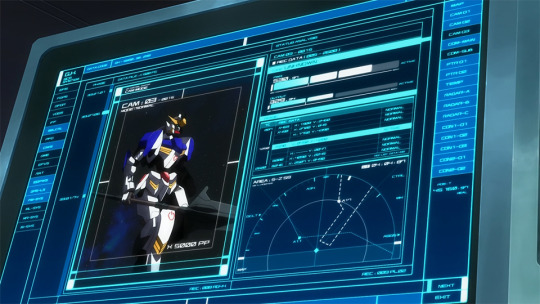
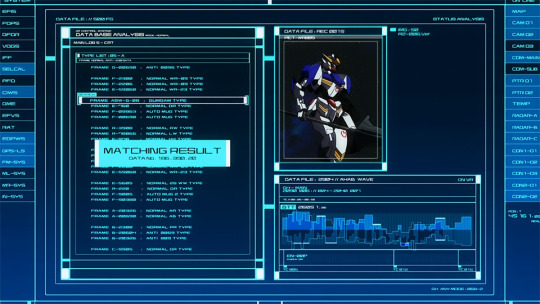
The entries here are fairly meaningless in terms of wider canon details but for posterity, here's a breakdown.
Barbatos aside, each frame number takes the form of a letter followed by a three, four or five digit number. Examples include 'E-978', 'R-3908' and 'C-09067'. These are shown to be equivalent to 'ASW-G-08', so presumably identify the specific frame/'suit. The second term appears to indicate the kind of mobile suit listed, since Barbatos' is 'GUNDAM TYPE'. Outside that, however, they don't accord with the more commonly used terms like Rodi, Graze or Geirail. We've instead got things like:
NORMAL WR-09
NORMAL PR
NORMAL 26 WW
NORMAL GERA
AUTO MUG
AUTO MUG 2
ANTI 809
And so on, with variations of these general formats. As I said, this isn't especially meaningful, though it does give us a code for Barbato's database entry (186.390.20) and, together with Ein's POV, establishes that Ahab signals take the form of bar graphs -- although, here at least, there is little in the graphics to indicate much difference between Crank's single-reactor Graze and the dual-reactor Gundam frame, a distinction described by the dialogue.
While we're on the subject of screens, we may as well take a look at the following two as well, which provide a little bit of additional world-building.
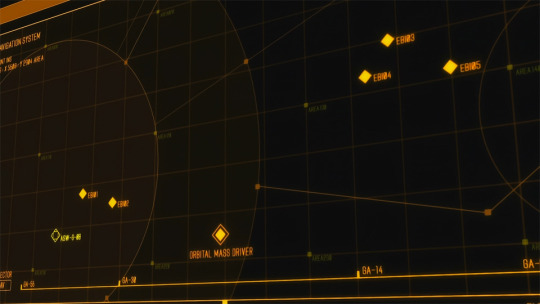
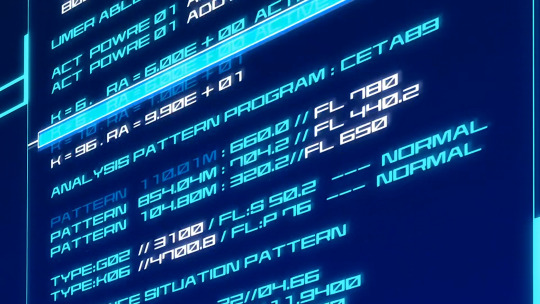
First we have the display from Orcus' ship, showing an overview of the battlefield. Interesting, it indicates Barbatos' frame code in full, suggesting this is broadcast as an IFF signal, which is rather funny given the extended search sequence that follows on Gjallarhorn's side.
We also see the Grazes in play identified using codes such as 'EB101', 'EB102', 'EB103' and so on. Now the Graze frame's model code is 'EB-06', indicating it is the sixth mobile suit Gjallarhorn have developed since the Calamity War (predecessor Geirail is EB-04). We can infer therefore that 'EB' is a standard designator for a Gjallarhorn 'suit, making it likely these are just generic IDs assigned from Orcus' perspective.
More interestingly, this screen picks out one of the structures in the vicinity of the battles as an 'orbital mass driver'. This is presumably the large satellite the shuttle skims past as it tries to evade the first three Grazes to come after Tekkadan.
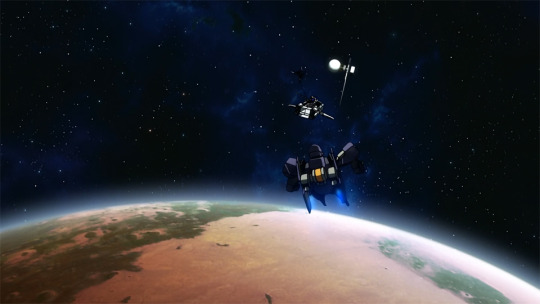

Together with the mining asteroid, this is gives us a brief indication of industry going on in Mars orbit. What exactly the mass driver is being used to launch and where is never made clear, although we are told that Mars' main export is the 'half metal' used to dampen Ahab reactor emissions, so it's plausible this forms some part in that. It's a pretty nice design at least, using the same spherical core as Gjallarhorn's space stations and the larger space dock, but with an unusual asymmetric rotating boom and a stationary rectangular module on the end.
The second screen shown above is the attitude control program running aboard the Schwalbe Grazes, shown as McGillis commentates about Gaelio's inability to hit Barbatos. I love how this highlights that standard mobile suits are doing a lot of computing in order to enact what their pilots want. This is something that's been made explicit in Gundam shows right from the very start, but it's rarely more than a passing detail. In Iron-Blooded Orphans, by contrast, it's part of the central conceit that the Alaya-Vijnana allows people to operate machinery much more effectively, by making it a direct extension of their bodies. Gaelio can't hit Mikazuki explicitly because his Schwalbe's software struggles to predict Barbatos' more instinctive movements. We see the program cycling through different patterns as it attempts to lock on, and might infer this must go both ways, with the program analysing an enemy and deploying a corresponding attack or defence response.
We've seen before that Barbatos moves far more fluidly than the Grazes; this nicely underlines the point and provides a bit of technobabble to quantify the advantage that will carry Tekkadan so far. Gjallarhorn's mobile suits appear more robotic because they are -- something with interesting implications given we eventually learn that an excessive degree of weaponry automation caused the Calamity War, and that will provide a moment of sharp dissonance when the Graze Ein appears during the season finale, fully emoting with human-like gestures.
Alas, in all this, we never do get any hint this is where Tekkadan acquire the bazooka, if that was indeed the intention all along. To be fair, we don't see what Akihiro is doing after a certain point in the fight, so there's plenty of room to posit a missing scene. But I have to say, from a continuity management perspective, I would personally have had them recover it after the ground battle in the opening two episodes. For one thing, the alternative shoulder armour is painted dark green, in line with the land-based Grazes rather than the detachment from Ares. For another, that initial battle is one Gjallarhorn soundly lose, as opposed to 'merely' failing to stop the Isaribi escaping. Wouldn't it have made slightly more sense for the boys to happen upon an abandoned equipment module once Gjallarhorn's mobile workers had cleared out?
It's a very minor detail; the bazooka isn't even especially plot-relevant (more 'let's sell more toys!' relevant; yes I am writing this while building the Graze Custom kit, why do you ask?). There's a much more obvious continuity problem in 'Beyond the Red Sky' that you might already be aware, where after being visibly winged by one of McGillis' shots, the sub and dub script have Mika say "that would've hit me," as if the bullet had missed (not quite sure if that's confusion caused by the original Japanese in some way?). But this is just a case of the script or versions of the script not keeping pace with the animation, or simply being ambiguous -- and anyway, it can be rescued as part of the point being made by assuming that since Mika hasn't yet adjusted to treating Barbatos' thrusters as an extension of his body, he's treating this hit as a near miss.
The bazooka thing stands out far more in an episode that otherwise effectively sets various things up or builds on already-established details. It's a case of something going unjustified in the text, which is quite unusual for materiel in this show. Usually, we can trace exactly where each of piece of military hardware the boys use has come from, highlighting the persistent through-line about how important logistics are in the fight for survival.
I'm not surprised there were queries about it at the time, and while the answer listed on Gundam Wiki is serviceable enough, it does still rely on finding a convenient void in the action, rather than being textually established.
[Index of other writing]
#gundam iron blooded orphans#gundam ibo#g tekketsu#tekketsu no orphans#reference#notes#ein dalton#eugene sevenstark#mcgillis fareed#mikazuki augus#gaelio bauduin#graze#gundam barbatos#slightly rambling analysis of various small details
10 notes
·
View notes
Text
Few countries’ economies are so bound to one resource. Global Witness, an international watchdog that monitors natural-resource exploitation, estimates that Myanmar’s jade trade was worth up to $31 billion in 2014, nearly half the nation’s GDP that year. Yet the industry remains shrouded. The ethnic Kachin, though native to the jade hills, control few of the mines. In the 1990s, the Kachin Independence Army (KIA), one of several ethnic armed groups fighting the state in Myanmar’s borderlands, lost control of territory around Hpakant.
Today most of the big concessions belong to companies or cronies connected to the Burmese military elite. Even as the country has transitioned from five decades of military rule to semicivilian authority, jade has proved the limits of democratic governance. Most stones are smuggled over the border to neighboring China; only a fraction are subject to the tax needed to fill government coffers in one of Asia’s poorest countries. The scale of graft and unaccountability is such that Global Witness calls Myanmar’s jade economy the “biggest natural-resource heist in modern history.”
[...]
The world’s best jade mines are sealed off to nearly all foreigners. But I managed to access Hpakant to experience a place so beguiling to 18th century Chinese imperial envoys that hundreds perished en route in the malarial wilderness. The scenes before me look like a cross between a magnified ant farm and a Star Wars set. In the distance I spy what appear to be hundreds of tiny insects clinging to a hillside. As we drive closer, I realize they are men. Backhoes, excavators and giant trucks maneuver through a lunar landscape like creatures from an alien planet. Hpakant was once the domain of tigers and verdant foliage. All I see is dust and brown. Where prospectors used to dig by hand, now explosives and heavy machinery, mostly imported U.S. or Chinese brands, are ripping the entrails out of jungle, demolishing entire mountains within months. Already, Hpakant is mostly dead.
Fatal accidents mount. Only the biggest, like a November 2015 landslide that killed about 200 miners, make headlines. Township officials have recorded hundreds of deaths in jade-mining accidents over the past year and a half. But locals say the real number is many times that. And in the hills, the Burmese army and Kachin rebels continue to wage war. “If there was no jade, there would be no war in Kachin state,” says Yup Zaw Hkawng, an ethnic Kachin who owned large mining concessions before the Burmese military wrested control of Hpakant. “We are living and sleeping on so much jade in our earth, but jade is Kachin’s curse.”
[...]
Sequestered from the outside world, Hpakant radiates a gold-rush lawlessness. Unexplained killings occur with regularity. While we are there, a schoolteacher is shot in the head. The day before, a jade trader died from an executioner’s bullet. Last year bombs exploded at the headquarters of two mining companies. In November, a jade scavenger at Hmaw Sisar mine was shot dead by military intelligence or the KIA, depending on who’s telling the story. “There is no real law in Hpakant,” says one of the immigration officers holding us, with a touch of apology. “We don’t know who to trust.”
22 notes
·
View notes
Text
Snippet - Forward, but Never Forget/XOXO - The Council

Silco meets the Council. And ponders his history.
Forward, but Never Forget/XOXO
Snippet:
Hatred rises like a toxic effervescence in Silco’s veins.
(These Pilties, eh, Vander?)
(These fucking Pilties.)
In a city whose lifeblood is old money, they are the crème de la crème: an elite group steeped in Piltover's rich heritage of trade and commerce. A century ago, the city was a drowsy backwater, a middling port of fishing settlements and warehouses. The Council's forefathers were Shuriman midshipmen, Ionian merchants, Noxian brigands and Demacian bureaucrats. Men and women who made their fortunes through sheer tenacity and hard graft.
Then came the boom.
Beneath the settlement lay caverns with rich deposits of minerals. Soon, smelters dotted the waterfront, and shipyards sprang up along the bay. Steel became gold. Iron turned to platinum. The age of industry dawned: Piltover blossomed into a manufacturing metropolis.
Then came the Void Wars. In a trice, the city's population doubled. Zhyunian refugees fled by boat; Noxian merchants came by steamships; Demacian scholars boarded trains and Freljordians rode in on zeppelins. Language diversified; the city grew cosmopolitan.
In the coming decades, successive waves of migrants were swept onto Piltover's shores: from noble families seeking to expand their power across Valoran to small-town traders laden with cheap luggage and big dreams. By the century's end, they'd propelled Piltover into a global megacity of palatial mansions, art deco skyscrapers and pristine streets hosed clean every morning before the business hubs threw open their gilded gates to the bon ton.
The population boom meant more houses to build, more food to eat, more clothes to wear. All of which required labor, capital investment, and raw materials.
All of which came from the Fissures.
In theory, the Undercity should have prospered hand-in-hand with Piltover. Yet little of the riches from the Fissures’ recesses was ever relished by the Fissurefolk themselves. They were cut from a different cloth from their over-the-Pilt brethren. Their ancestors were miners and craftsmen, not shipmasters and merchants. Their culture was a clotted stew of customs and dialects; most didn't even speak Piltovan. They weren't born in the city itself but in its shadow, living in close-knit riverside settlements and twilit caverns.
Physically, they resembled deepwater piranhas compared to their sun-kissed kin—narrow bones, wan skins and sharp teeth. Culturally, they were foreigners. And socially, they were inferiors.
Their economy was a rich relic of the Oshra Va'Zaun empire. Their gemcraft and metalworking industries were well-established. Their artisans were peerless and prolific. Their alchemical scholars were the backbone of innovation. They had a robust labor force, a thriving entrepreneurial class, and a history of keen ingenuity.
Their forbearers traded along a flourishing network of maritime ports and river routes. They bartered with Bilgewater; bankrolled the gold mines in Shurima; forged trade deals with Ionia. They even had stakes in the black markets of the Shadow Isles and the mercenary guilds of Noxus.
They did business with every corner of Runeterra. And they did so proudly.
A century's time would turn the glad tidings into bitter tides.
During the first wave, the Undercity's wealth was a windfall for Topside. The demand for labor and resource was insatiable. But the Undercity's resources were finite. When Piltover's population ballooned after the Void Wars, the Fissurefolk were forced to compete. Lacking the natural advantage of fertile terrain and plentiful sunlight, they had no choice but to cut corners. In a trice, the factories and mines teemed with orphans and the elderly, each one paid starvation wages and offered none of the protections aboveground. By the century's end, the Undercity was squeezed dry, a sweatshop with a single employer.
Piltover.
As the upper-city's wealth quadrupled, mercantile clans rose up, each vying for control over the mineral deposits in the Fissures. These overlords were no friends of the poor. Their purview was profit, and profit meant one thing above all else:
Exploitation.
Their first order of business was stymieing the Undercity's trade routes and keeping its resources under lock and key. The collapse of the old Sun Gates and the flooding of the Undercity’s ports gave them the perfect pretext. The borders were sealed off in the guise of a safety net. The only routes were now through Piltover's Bridge, and each shipment was heavily taxed.
In time, the Undercity’s local markets choked. A slow strangulation of wealth reduced former artisans and alchemists to scavengers. Tariffs trapped them in a perpetual cycle of debt and debasement. Once-proud traders stooped to selling their own daughters for coin. Others tipped over into outright smuggling.
Then Piltover launched its second phase: a systematic strangulation of the Undercity's voice.
Fissurefolk were barred from owning or leasing property aboveground. Their children were denied access to Topside schools. Their customs were deemed barbaric. Their traditions were branded as backward. Their dialect was derided as guttural filth. They were derogatorily referred to as Sumprakers—as if their entire existence was an aberration.
By the century's end, Piltover had transformed from a trading partner into a hegemony. The Fissurefolk were no longer perceived as citizens, but as the Other.
An enemy within.
Soon, Topside began consolidating power by buying up land around the Fissures. Displacing the poor and demolishing their homes, they drove them deeper and deeper belowground, while putting the leftovers to use. Historic districts were privatized. Temples were razed. Marketplaces were shut down. The Undercity was reduced to a febrile womb of raw material, ready to be ravaged.
And ravaged it was.
When the first mining rig was installed, the Fissurefolk rioted. The unrest was put down. More mines followed, and more violence. It wasn't until the Enforcers were established as a body of justice that the tide turned in Topside's favor. These overseers were a law unto themselves, their ranks composed of mercenaries and miscreants. Their uniforms were black; their hearts were blacker. Their methods were a brutal amalgam of medieval torture and modern bureaucracy.
Under the banner of peace, the Enforcers were tasked with quashing dissent belowground.
They did so—brutally.
Piltover's third phase was total dominion.
The first mercantile houses had grown rich off the Undercity's spoils. But the new generation hungered for something more: absolute rule. They were no strangers to political maneuvering. Their forefathers had been shrewd tacticians: men and women who'd honed their wits through war, diplomacy and backroom deals.
They knew how to twist the knife, and keep their own hands clean.
Before long, they'd allied with Piltover’s industrial magnates and the monied elite. Together, they formed a cabal of oligarchs, each as ruthless as they were influential. Thus, the Council was born: a body of seven self-appointed sovereigns charged with regulating trade, enforcing laws and levying taxes.
They saw the Fissurefolk as a means to their own end. Disregarding their petitions for better sanitation, downplaying the contributions of their labor, and turning a blind eye to the rampant pollution, they proceeded to carve the Undercity's soul from its body.
When the Fissurefolk protested, the Council responded with Enforcer raids.
And bloodbaths.
By century's end, the Council had built a wall of bureaucracy between themselves and the Fissurefolk—most of whom were treated with neo-colonial contempt. Meanwhile, their wealth continued to reach dizzying heights, with every merchant ship that sailed through the port's grand arches and every sculpture patronized by celebrated virtuosos in their mansions.
The Hex-Gates only quadrupled their fortunes. With every invention by Talis, investors flocked and the Council’s influence grew. The wealth they had hoarded was now limitless. They could build a brand-new city, if they so desired. But why should they, when the Trenchers had already done the hard work for them?
Today's Council—Hoskel, Salo, Bolbok, Shoola, Medarda, Kiramman—are Piltover's pivotal political force, decreeing laws with a gesture from their grand parlors. They're the ones who decide whether jobs are created or lost, how many schools are funded, what taxes are levied.
They make decisions that affect every citizen in the city—every bloody day.
They are also corruption incarnate. Yearly, they’ve swallowed over one-third of the allocated Undercity budget, without accounting for a single cog. Between them, they preside over an empire of private business interests in everything from real estate to racehorses, stowing away their wealth in Demacian bank accounts, Noxian jewelry splurges and private islands dotting the annexed Ionian shores.
To them, Silco's coal-mining origins are as offensive as a rat turd in their caviar. Among Topside's upper-crust, he's a social climber, a rabble-rouser, and a scabrous opportunist. He wasn't born into privilege: he made his wealth through the cutthroat crudeness of industry.
More offensive still, he keeps a singlehanded stranglehold on his fortune, no different from a smuggler stowing all his coins in his codpiece. He never invests in stocks or allows Piltovans to buy shares in his enterprises. Like his factories, everything he owns belowground—publishing houses, restaurant chains, repair garages, gyms, nightclubs, salons—employs Fissure-bred workers, and is rumored to be a front for funding anarchism.
As if that weren't bad enough, he has no inhibitions in debating money or politics in their glittering ballrooms. Worse, he mocks them for entertainment—all while displaying impeccable manners.
Case in point—
With grave courtesy, Silco bows his head, "Councilors."
#arcane#arcane league of legends#arcane silco#silco#forward but never forget/xoxo#forward (never forget)/xoxo#arcane jinx#jinx#arcane mel medarda#mel medarda#arcane jayce talis#jayce talis#arcane cassandra#cassandra kiramman#arcane hoskel#arcane shoola#arcane bolbok#arcane salo#arcane vander#vander#snippet
44 notes
·
View notes
Text
@kla1991 replied to your post “I still have no idea why American Girl did a...”:
Do you have thoughts on who would be on Nikki's pokemon team? I was not quite a tomboy in 1999 but I was totally feral about pokemon and that doesn't really wear off.
Okay so APPARENTLY my memory has been wrong for the last 20 years? Because I stg since high school, I was under the impression that I got my kiwi Gameboy Color and Pokemon Gold for my 12th birthday -- but Pokemon Gold/Silver didn't release in North America until October 2000 which means I couldn't have gotten it until my 13th birthday. :| (And the Zelda Oracle of Seasons I remember getting for Christmas 7th grade wasn't released until mid 2001 which would make it Christmas 8th grade for me !!!)
Time is weird, I guess. Anyway, that means Nikki and her twin Isabel could only be playing Pokemon Original Flavor in 1999. Unfortunate, because I have much less personal experience with Red/Blue but also fortunate because 151 pokemon is a lot less to choose from than the 300+ in gen 2.
Disclaimers: It is impossible to select Nikki's pokemon team without also selecting Isabel's, so you're getting both. Also, I chose these without reading their corresponding American Girl books and without regards to type-matching against the Elite 4. We're going purely off of vibes here.
To start, these girls would've started playing Pokemon between 7-9 (they're 9 on NYE 1999) and while their mom is in the tech field, I don't think they would've dug into version exclusives at that age before selecting their Pokemon games. It'd be more about favorite colors and the pokemon on the box. So, Nikki picks Blue because it's closer to purple and Isabel picks Red because it's closer to pink.
Nikki likes Blastoise on the box and if they've watched any of the anime, she might know Squirtle has some punk attitude which she'll like as a skateboarder and daughter of a grunge band member. Isabel chooses Bulbasaur because she's not super interested in fire. By sheer luck, neither pick the hard mode starter and both skate through the first gym just fine. (Unlike me, haha)
No one raises Magikarp, even after they learn about the Gyarados evolution. Both have Pikachu in their parties, especially if they watch the show. Nikki evolves her Eevee into Flareon to have a fire type. Isabel evolves hers into Vaporeon. You get to pick your fighter after beating the fighting gym leader, if I remember right? As the skateboarder, Nikki chooses HItmanlee, the kicker. Isabel plays tennis and chooses Hitmonchan the puncher.
Isabel is CRUSHED when she learns Vulpix is only in Blue, so Nikki traders her one for her team. She also has Jigglypuff for the pink and cute vibes, and definitely sings the Jigglypuff sleep song when Nikki annoys her. Nikki rounds out her team with a Magnemite -- chosen solely for the vague hoverboard vibes they give off. And Articuno. Neither of them are patient enough to bother with Gyarados, but Nikki WILL catch one of those legendary birds dangit! No matter how many times she has to quit without saving.
In conclusion:
Nikki's team: Squirtle, Pikachu, Magnemite, Hitmonlee, Flareon, Articuno
Isabel's team: Bulbasaur, Jigglypuff, Vulpix, Pikachu, Hitmonchan, Vaporeon
And while they might easily be playing on original Gameboys, I'm still assigning them Gameboy Colors. Nikki has it in Grape and Isabel has Berry.
#kla1991#reply#THANK YOU FOR ASKING AND MAKING ME THINK ABOUT THIS!#It was fun!!#Even if it did rewrite my memories of childhood ROTFL#my meta#(For American Girl dolls????)#(look idk BUT IT WAS FUN!)
2 notes
·
View notes
Text
„The style of dress portrayed by Homer and early Greek artists is transformed in the course of the later seventh and sixth centuries bc. Male costume develops in the direction towards which the Homeric pharos already points, increasingly favouring the display of wealth and leisure: very large wraps, multicoloured tunics, headgear, and wreaths all come to be worn by men, and even the parasol becomes an acceptable accessory for gentlemen of leisure. By about 600 bc, class differentiation has developed to a point where animal skins are regarded as ‘rustic’ dress and contrasted with upper-class costume, in a way alien to Homer and Hesiod. In these circumstances, the traditional dress code for men, which emphatically signalled a man’s readiness to engage in energetic and dangerous outdoor activities, is no longer appropriate for the elite, who must forego this way of displaying masculinity. Female dress, meanwhile, is widely subject to sumptuary legislation, and in Athens and Ionia, where men adopt trailing tunics, women lose even the peplos itself, along with its conspicuous pins and fibulae, and don linen tunics instead (Herodotus 5.87–8). Clothes here reflect a trend which sees the social role of women grow more circumscribed, with ‘respectable’ women expected to lead relatively secluded lives and not make a show of their sexual attractiveness, let alone enhance it by means of their clothes. In the Homeric world, a married woman could wear a large, lustrous, purple peplos and be admired for her looks; she could even play an active role in buying prestige items of dress which she did not herself produce. When a Phoenician trader came knocking with a gold-and-amber necklace to sell, it would be the mistress of the house and her maids who gathered round, and ‘ran their hands over it and scanned it with their eyes, as they named a price’ (Od. 15.459–63). In archaic Greece, such behaviour comes to be considered outrageous, as best illustrated by the laws of Syracuse and Locri. These not only forbid women to wear gold ornaments, let alone buy any, but reflect a conception of gender so different from Homer’s that they redefine the meaning of the colour purple when used in a woman’s dress: far from being a legitimate means of enhancing her sexual appeal, a purple dress now marks the wearer as ipso facto a prostitute.”
- Clothes, Class and Gender in Homer, Hans van Wees
2 notes
·
View notes
Text
In the 1360s, secrets, also known as particolored garments, were all the rage in Europe. These garments were characterized by having different colors or patterns in different parts, often in a contrasting or complementary fashion. They were seen as a sign of wealth, luxury, and sophistication, and were popular among members of the nobility and upper classes. But why were secrets particolored, and how did they become such a sought-after fashion statement?
One theory suggests that the trend of particolored secrets began as a way for European merchants to showcase their wealth and success. In the 1300s, trade and commerce were expanding rapidly across Europe, and merchants and traders were becoming increasingly affluent and influential. As a result, they sought ways to display their wealth and social status, and one way they did this was by wearing expensive and fashionable clothing.
Particolored secrets were perfect for this purpose, as they were made from luxurious fabrics, such as silk, velvet, or brocade, and often adorned with ornate and costly embellishments, such as fur trims, gold thread, or gemstones. These garments were not only visually striking but also symbolized the wearer's wealth and status, making them a desirable fashion item among the elite.
Another theory suggests that the trend of particolored secrets emerged as a way to imitate the clothing of the ruling class. During this time, Kings and Queens in Europe often wore garments that were adorned with multiple colors and patterns, as a symbol of their power and authority. Nobles and wealthy merchants sought to emulate this style to elevate their own social standing and create a sense of glamour and prestige.
The popularity of particolored secrets also coincided with advancements in textile production and dyeing techniques. Prior to the 14th century, fabrics were mainly dyed in solid colors, but during this time, new techniques were developed, allowing for more intricate and varied patterns and colors. This made it easier for tailors and seamstresses to create the intricate designs and patterns seen on particolored secrets.
Furthermore, the trend of particolored secrets was strongly influenced by the European fashion capital, Italy. Italian cities such as Florence, Venice, and Milan were known for their thriving textile and fashion industries, and it was here that the latest trends and styles were born. Secrets, with their diverse colors and patterns, were a symbol of the Italian fashion aesthetic and quickly spread across Europe.
In conclusion, in the 1360s, secrets were particolored as a way to display wealth and social status, imitate the clothing of the ruling class, and to showcase the advancements in textile production and dyeing techniques. These luxurious and fashionable garments were a reflection of the cultural and societal changes happening during this time and remain a fascinating aspect of medieval fashion history.
0 notes
Text
Join Me in the GOAT1001 Trading Competition!

Hey everyone! I’m thrilled to announce that I’m joining the GOAT1001 Trading Competition by ORION Trading Academy, and I want you to join me. This is an incredible opportunity to enhance our trading skills and be part of an elite community of traders.
Why You Should Join
Learn from the Best: Access the ORION Trading Strategy, which boasts an impressive 80% win rate. This strategy has been proven over 7 years, delivering up to 30% annual returns without leverage. It’s a fantastic opportunity to learn and apply these successful trading techniques.
Compete and Grow: The competition starts with a $100,000 demo account, where we can practice and refine our strategies. We’ll be competing in private groups with daily and weekly rankings, which will make the learning process fun and engaging. After the demo period, we’ll move to real trading with a $1,000 live account. This practical experience is invaluable and will help us build confidence in our trading abilities.
Earn Big: As we progress through the competition, there’s the potential to earn up to $10,000 monthly. For those who excel, there are opportunities to manage large capital starting from $100K and beyond. This is a chance to not only improve our trading skills but also significantly boost our earnings.
The Competition Stages
Stage 1: Demo Selection Period (1 Week)
We’ll start with a $100,000 demo account, trading 10 lots per currency pair and 5 lots per gold transaction, following strict strategies for entry, exit, and stop-loss operations.
We’ll compete in private groups, enhancing our skills through daily and weekly rankings.
Every participant will receive a certificate of completion, regardless of performance.
Stage 2: Practical Assessment Period (1 Month)
We’ll trade with a $1,000 live account, trading 0.1 lots for currency pairs and 0.05 lots for gold, following strict strategies. This stage tests our real-world trading abilities.
Stage 3: Signal Trader Program (Long Term)
We’ll use a $1,000 live account provided by the company, trading 0.1 lots per currency pair and 0.05 lots per gold transaction.
There’s the potential to earn up to $10,000 monthly and manage significant capital, with the company promoting our trading signals for more exposure.
Join Me in the Adventure!
This competition isn’t just about individual growth; it’s about building a community of like-minded traders. By joining the GOAT1001 Trading Competition, you’ll connect with traders from around the world, share insights, and support each other on the path to financial freedom. ORION Trading Academy and DecodeEX are dedicated to helping us achieve our trading goals with confidence and ease.

Let’s Do This Together!
I’m all in, and I’d love for you to join me! Sign up for the GOAT1001 Trading Academy, claim your spot, and let’s embark on this exciting adventure together. We’ll learn, compete, and grow as traders, all while having a great time.
Don’t miss out on this incredible opportunity to transform your trading game. Click the link to learn more and secure your spot!: https://www.orionta.com/
#GOAT1001 #WeAreOrion #TradingCompetition #JoinMe #TradingSuccess #FinancialFreedom
#forexmarket#forex brokers#forex#forex trading#forexeducation#forextips#forexstrategy#forex traders#forexmentor#forex online trading
0 notes
Text
🌟 Introducing KraitosX: The Best Gold Expert Advisor for Trading Gold in 2024! 🌟
🚀 Are you ready to elevate your trading with the best gold expert advisor? Look no further than KraitosX, exclusively brought to you by Auvoria Prime. Our cutting-edge expert advisor for gold trading is designed to optimize your trading strategies, ensuring maximum profitability in the dynamic world of gold trading.
🔍 Why KraitosX?
Advanced Algorithms: Tailored for the intricacies of gold market dynamics.
User-Friendly: Perfect for both beginners and seasoned traders.
Consistent Performance: Proven track record in diverse market conditions.
💡 Discover the future of gold trading and why KraitosX is your go-to Expert Advisor for Gold Trading in 2024. Dive into detailed insights and user testimonials at our website.
👉 Learn more about this Expert Advisor for Gold Trading tool and transform your trading journey:
Join the league of elite traders with Auvoria Prime and KraitosX - Your golden key to trading success!
#kraitos#expert advisor#forexsignals#expert advisors#forexstrategy#forex#forextrading#forexindicator#gearbox#auvoriaprime
0 notes
Text
Report: Cryptopunks and Blue Chips Power Top NFT Traders to Over $300 Million in Profits

Navigating the NFT Gold Rush: Coingecko Uncovers Strategies of Top 15 Profitable Traders
In its latest NFT analysis, Coingecko details that the top traders in the NFT arena have earned between $3.3 million and $101.6 million individually, cumulatively exceeding $300 million. The report explains the strategic investment choices and collections that have fueled the success of the foremost NFT traders.
Delving into the profits of the top 100 Ethereum NFT traders, Coingecko’s study discloses the most significant victors of the market thus far. This analysis focuses on traders’ realized profits, meaning the tangible earnings secured through NFT sales. To qualify for this elite list of 100, traders were required to exhibit consistent activity over the past half-year and possession of no fewer than two collections.
The study illustrates that the leading NFT traders predominantly wagered on blue chip NFT collections at an early stage, an investment that has subsequently skyrocketed in value. Notably, Larva Labs’ Cryptopunks constitute an astonishing 70.6% of total profits for the top 15, followed by Art Blocks’ generative art at 12.2% and Bored Ape Yacht Club at 5.5%.
Occupying the zenith of the rankings, the NFT trader dubbed “Seths” boasts $101.6 million in realized gains to date. This vast fortune was cultivated across nine distinct addresses brimming with valuable Cryptopunks and other sought-after blue chip NFTs. Trailing in prestige, “Punks OTC” and “Mr.703” secure the next upper echelons with profits of around $29 million and $27 million, respectively.
Of the 15 top earners, 11 have extracted millions solely from Cryptopunks. For instance, trader 0x7eb2..3f6b clinched fifth place chiefly by selling one specific Cryptopunk to a renowned buyer. Conversely, some elite traders, such as Akira, directed their focus more towards Art Blocks.
Though these NFT moguls have reaped monumental wealth, the report underscores that this prosperity hinged substantially on early bets on the correct collections. Without astute identification of the upcoming blue chip collections, replicating such returns appears highly improbable. The study cautions average traders to diversify, to avoid losing opportunities in the few collections poised for explosive growth.
Coingecko’s NFT report can be read in its entirety here.
What do you think about the top NFT traders? Share your thoughts and opinions about this subject in the comments section below.
Read the full article
0 notes
Text
A Quick Intro About Rakesh Rajdev

Rakesh Rajdev is the name of courtesy in India. Mr Rakesh Bhai Rajdev's name will come to the mind of many people when they hear about philanthropic activities. He is a sign of emblem, a great philanthropist, a man of his word and a kind-hearted person. He is also a successful businessman.
Many people are curious to know more about Rakesh Bhai Rajdev. Are you one among them? Then read more here. Here you will get to know a glimpse into the life journey of Rakesh.
In society, we would have generally heard about many genetic traits which are transferred from generation to generation. But in the case of Rakesh Rajdev it’s the kind-hearted nature and philanthropy is the genetic trait which is transferred from generation to generation.
Rakesh belongs to Rajkot, Gujarat. He is a very famous businessman as well as a social worker of the state. He is also the owner of the luxurious three-star hotel namely Roma Kristo Hotel in Dwarka. The elite class family members and celebrities will visit the hotel to have some delicious food and great relaxation from their busy schedules.
He also runs UAE-based companies namely APM Intl DMCC, APM Capital and APM Bullion. These are trading companies where one can trade precious metals such as gold and silver. Also, the jewellery shop owners and wholesale traders can get the precious metals in large quantities and get them delivered to their locations with these companies.
Being a Nobel heart person he thought about the lower class people too. Hence he started supporting needy people and families as much as possible with his social welfare organization. He runs an NGO namely KanudaMitra Mandal since November 2011 to support the people. Their remarkable work was during the COVID-19 pandemic time.
Follow Us On Our Social Media Pages
Facebook, Instagram, YouTube
0 notes
Text
ViaMarketsGo Review – 5 Scary And Disturbing Facts About This Immoral Forex Scam
While trying to find more information about ViaMarketsGo Broker, we found that they are not actually regulated. They state that they are located in London UK. Companies that are trading under their regulation are not allowed to have cryptocurrencies available. According to the FCA.
Let’s find out more about ViaMarketsGo and why you shouldn’t commit to this scam. First, we will understand the importance of regulations.
ViaMarketsGo – A Scam Broker Without A License?
Licensed companies are obligated to disclose clearly all necessary information about their company. Starting with license number, location, contact information and more.
Since ViaMarketsGo trading doesn’t offer any of these, we can only assume that this is a complete scam. Especially since the company is located in the UK, that is to say, one of the strictest countries in terms of trading.
ViaMarketsGo has recently changed as well their domain, for allegedly security reasons. Likewise, now access to their website is restricted.
It’s an unreliable company, with a lot of negative reviews. Whatever reason you had to start trading here, you had many more warnings about why not to. That’s why you never invest with a non-licensed company.
Requirement Of Registration To Enter The Site

scambrokersreviews.com
When you are trying to get to their website, it is asking you straight to register to get access. That is unreasonable. Nobody would register for something they don’t know anything about.
However, companies that are regulated by Tier 1 Regulators are giving their offers transparently. Also, you can see what you can expect from the company.
Such regulators are FCA, BaFin or ASIC. Going through their register we couldn’t find any information about ViaMarketsGo.
Warnings Issued by Financial Regulators
Companies like ViaMarketsGo are often changing their domains to trick regulators as well. Since there are no warnings issued, that doesn’t mean they are clean. So, that just means that they are hiding well.
However, they can’t escape it forever.
What Platforms Does ViaMarketsGo Offer? – Trading Software
Traders are often using MT5 because it’s reliable. Thus, it offers a variety of TA tools that are making trading easier. ViaMarketsGo is offering besides the web-based trading platform, MT5 mobile version.
What clients are experiencing here are difficulties in terms of trading with a web-based platform. It is simplified and can’t compare with some more advanced ones. Besides, it is not rare that these platforms are often manipulated.
They are sometimes not in sync with real market data. Therefore that information can’t be relevant in trading.
Since MT5 is available only for mobile devices, whether iOS or Android, your possibilities are limited.
ViaMarketsGo Trading Instruments
Doing this ViaMarketsGo review we found that they offer different asset classes:
Forex – USD/JPY, USD/GBP, AUD/CAD
Commodities – Crude Oil, Gold, Platinum
Indices – DowJones, DAX30, CAC40
Stocks – Apple, Netflix, Disney
Cryptocurrencies – BTC, ADA, XRP
ViaMarketsGo Fraud Risk Zones – Service Countries
Unfortunately, there is no confirmation of what countries exactly they are targeting. Since they are saying that they operate from the UK, we can assume that it’s fake.
Therefore, possibilities are numerous. But some possible targeted countries according to ViaMarketsGo reviews are:
UK
Canda
Australia
Netherlands
Spain
Additionally, we strongly recommend that you avoid the fraudulent brokers Finero, UF Solution, and ImportCapital.
What Do We Know About ViaMarketsGo Account Types?
The company offers 6 different account types. Higher account types give you lower spreads and higher bonuses, which is not allowed according to regulations. They offer:
Standard – 1.000 EUR
Gold – 5.000 EUR
Premium – 10.000 EUR
Platinum – 25.000 EUR
VIP – 50.000 EUR
Elite – 100.000 EUR
Spreads are ranging from 0.2 for Elite to 1.8 pips for Standard accounts respectively. Likewise, maximum leverage, which is not allowed with licensed companies, is going up to 1:1000 for lower accounts.
Moreover, bonuses range from 50-100% of the initial deposit.
ViaMarketsGo Terms and Conditions
As a result of the ViaMarketsGo review, we realized that the company doesn’t offer any solid conditions. Since they are not regulated by any conduct authority, whatever is stated on their website is questionable.
Trading terms and conditions are not reliable. Also, any company that is licensed should not have bonuses and such high spreads. That leads us to the conclusion, that company’s goal is just to lure you to invest as much as possible.
Bonuses are designed to trick clients into investing more money. Moreover, these companies are often lowering their initial minimum requirement to get you on board. So, once you do that you are in a rat race with them.
However, bonuses often can’t be withdrawn, unless you have made 30 times more than you invested plus the bonus amount. Once you have reached your maximum, they never get back to you.
And then disappear completely at one stage.
ViaMarketsGo Broker Scammed You? – Please Tell Us Your Story
This immoral company is scamming people across the world. If you were caught in this scam you should know that not everything is lost.
First, let us hear your story. We are sure that in every story, there is something new. When you share your story we can find another solution to get in a way of these bogus scammers.
Moreover, our experts can assist you in getting your funds back! Chargeback is a solution. Therefore, book a free consultation now!
What Is the Chargeback Procedure?
A chargeback is a process required often by a customer to reverse a transaction. These transactions need to meet some requirements to comply with the rules for a chargeback. If you have used a Debit/Credit card, in the first 540 days you still have a solution.
1 note
·
View note
Text
Businesses Run By Rupalben Rakesh Rajdev

Rupalben Rakesh Rajdev – Have you head about this business woman? If you are in North India, especially in the state of Gujarat, then you would know about this inspiring woman. Rupalben Rajdev is the wife of Rakesh Bhai Rajdev who is a famous businessman and philanthropist in the state.
Both Rupalben Rajdev and Rakesh Bhai Rajdev motivate and inspire a lot of youngsters in India. Both of them run business successfully but also actively work in uplifting the society and support many families as well as people.
They run a social welfare organization namely Kanuda Mitra Mandal. This charity and social welfare organization is popular and actively known among the people since Rakesh and his team actively participate in social welfare activities. They have helped countless families and people with the organization.
Rupalben Rakesh Rajdev is the director of two high profile companies in India which are registered with the Ministry of Corporate Affairs (MCA). Roma Kristo Jewels Private Limited and Roma Kristo Ventures Private Limited are the companies which are run by Rupalven Rajdev. These two companies are located in Ahmedabad. Since these companies are trading companies Rupalben also work as a trader.
Rupalben Rajdev also supports Rakesh Bhai Rajdev in running the companies in Dubai. They also run the companies namely APM Intl DMCC, APM Capital and APM Bullion. These are trading companies where one can get gold and silver bars. Also, people can trade these precious metals here. If you opt for getting it delivered to your location, you can contact the companies to get it.
Both of them also run a three-star hotel namely Roma Kristo Hotel at Dwarka. Here usually elite class family members will reach the place and enjoy their free time . Though both Rupalben Rajdev and Rakesh Rajdev run businesses, they also support many people through their NGO for their better life.
0 notes
Text
Tablets, or pills, have been used for centuries as a means of administering medicine. However, in the 1550s, the use of tablets in the field of economics caused quite a stir and was seen as opposite to the traditional economic practices of the time. This divergence in opinion was due to several reasons.
Firstly, tablets were a relatively new form of currency that started gaining popularity in the mid-1500s. Unlike the traditional coins made of precious metals, tablets were made of compressed materials such as clay or wax and were easily transportable. This made them a convenient means of exchange, especially for long-distance trade. However, since tablets were not backed by any intrinsic value, they were seen as a risky form of currency by the conservative economic thinkers of the time.
Moreover, tablets, unlike coins, did not have a standard weight or size and varied from region to region. This lack of uniformity made it difficult for traders to accurately assess the value of tablets, leading to uncertainty and speculation in the market. This, in turn, made tablets a less reliable means of payment and hindered their widespread use in economic transactions.
Another reason why tablets were seen as opposite to traditional economic practices was that they challenged the concept of "hard money". In the 16th century, the dominant economic theory was based on the idea that only tangible assets, such as gold and silver, had inherent value and could serve as a stable medium of exchange. Tablets, being made of non-precious materials, were seen as a departure from this belief and were often looked down upon by the economic elites.
Furthermore, tablets were easily counterfeited, which increased the risk of fraud in economic transactions. In a time when trust and reputation were crucial for business dealings, the use of tablets as currency raised significant concerns among merchants and traders.
The skepticism towards tablets as a reliable means of exchange led to several debates and discussions among economists and merchants of the time. While some saw the potential of tablets to revolutionize the economy, others remained staunchly opposed to their use. This divide in opinion further added to the controversy surrounding tablets in the 1550s.
In conclusion, the use of tablets as currency in the 1550s was met with opposition and skepticism due to their lack of intrinsic value, variability, and susceptibility to fraud. This led to a clash between traditional economic beliefs and the emerging use of tablets, causing them to be seen as opposite to the established economic practices of the time. However, as the years passed and tablets proved to be a convenient and efficient mode of payment, they gradually gained acceptance and became an integral part of the modern economy.
0 notes
Text
Decentralized Finance: A Profitable Alternative to Traditional Banking
youtube
If recent events have shown us anything, it’s that the traditional banking system isn’t as stable as people hoped.
Two global financial crises in the course of fifteen years is enough to leave anyone jaded. And astronomical inflation and a shaky global economy have left people running in every direction, searching for something to hold onto.

For many people, traditional assets like gold or land are the only sure hedges against inflation and other macroeconomic earthquakes. But a growing number of people have begun exploring emerging, digital assets. Blockchain technology has made it possible to create entire economies on the internet, powered by code rather than by central banks or governments. It’s an evolving concept known as decentralized finance, or DeFi.
DeFi offers a number of advantages over traditional banking, including greater transparency, increased security, and lower costs. But those aren’t its only benefits. DeFi has the potential to deal with the world’s inflation problem once and for all. And it could benefit you in even more immediate, tangible ways.
So, let’s explore the world of DeFi, including the difference it could begin making in your life right now.
What is decentralized finance?
DeFi refers to the shift from traditional, centralized financial systems to peer-to-peer finance enabled by blockchain technology.

In a traditional financial system, transactions are processed by central institutions like banks or government agencies. These institutions act as intermediaries between parties, verifying and facilitating transactions. This means that they can control the flow of money and information, which gives them an inordinate amount of power.
Blockchain technology breaks the monopoly previously held by central banks and governments. It allows transactions to be recorded simultaneously across a vast, interconnected network of computer nodes. And since every computer on the network has a copy of the whole ledger, each being updated at the same time, it’s impossible to hack or illegitimately alter. The blockchain distributes power democratically, across the whole network rather than placing the trust and control in the hands of private or nationalized entities, aka the elites, the few, the powers that be.
In 2015 when Ethereum was created the possibility of true DEFI was born. Taking things a step further than Bitcoin, the original cryptocurrency, Ethereum has incorporated code into its blockchain. This has allowed for the creation of “smart contracts” on the platform, multiplying its potential exponentially. This is the reason it’s become a growing ecosystem of decentralized applications.
Ethereum offers alternatives to everything from loans and savings accounts to insurance and derivatives. By some estimates, the value locked in Ethereum’s DeFi protocols has already surpassed 31 billion dollars. With investments pouring into this emerging sector, it’s safe to say that DeFi is here to stay.
Ethereum was the first robust, programmable blockchain. The Binance Smart Chain, or BSC, also offers a secure, reliable platform for Smart Contracts, as well as the trading and staking a variety of tokens, including Ethereum, Cardano, and more. It also has some of the lowest gas fees available. Within the Binance ecosystem, users can enjoy various services, including margin trading and futures contracts. It’s also one of the few platforms that offer a decentralized exchange. This gives traders greater security and control over their funds.
DeFi as a hedge against inflation
Inflation is a major concern for anyone who holds investments in cash or other fiat currencies. Over time, the value of these investments will erode as the purchasing power of the currency declines. This problem only grows when governments and central banks suddenly increase the money supply as they have over the past few years.

Photo by Yassine Khalfalli on Unsplash
One way to protect against this is to invest in assets that are not subject to inflation, such as gold. But cryptocurrency can play a similar role. Most cryptocurrencies include a mechanism to increase the currency or token supply, but it happens at a more moderate pace. And generally, there’s no way for anyone to arbitrarily introduce mountains more all at once. This makes cryptocurrencies much more resistant to inflation than fiat money.
Another option is to use DeFi (decentralized finance) protocols to earn interest on your investment. These protocols are designed to function without a central authority, and they often offer much higher interest rates than traditional financial institutions.
DeFi as protection against macroeconomic events
One of the main advantages of DeFi is that it is not subject to the same regulatory restrictions as traditional financial institutions. This means that DeFi projects can offer a higher degree of security and transparency. In addition, DeFi protocols are often built on blockchains such as Ethereum and The Binance Smart Chain, which offer a high degree of flexibility and programmability. As a result, DeFi projects can offer a host of features and functionality.
One way that DeFi can protect you against macroeconomic events is by offering a level of flexibility that the traditional banking system cannot compete with. The REX protocol, for example, is comparable to a Certificate of Deposit, but with innovative investment features. This is a next-gen savings account that has built in investment features for accruing high APR rewards, called staking. REX also allows you to sell your stakes on the native Decentralized Stake exchange.

Learn more at REX.io. DYOR.
In addition, the decentralized nature of DeFi means that it is not subject to the same geopolitical risks as traditional financial institutions. This makes it an attractive option for investors who are looking for a secure way to invest their money in the same technology that is currently reshaping the internet and many other aspects of our lives.
DeFi as a passive income generator
One way investors earn passive income with DeFi is by staking crypto assets.
In the example of REX, when you stake your tokens, what you are really doing is converting your REX tokens into shares. Your shares represent the percentage of the APR generated by the smart contract and is directed to you as rewards. The more shares you have, the higher your APR will be. As your stakes mature you will unlock them, and the contract re-mints your REX back to you, along with all of the rewards that it generated for you. You may choose between selling your REX for BUSD, or creating what is called a Staking ladder.

REX COMMUNITY VALUES
A staking ladder is a calendar of stakes, and creating them is how the REX protocol is really meant to be used. The longest stake you can make in the REX protocol is 10 years. Some of our investors have stakes unlocking every month, or even every week. This generates a stream of passive income. One recommendation for Investors could be to sell the rewards of a mature stake as passive income, and re-stake the principal for 10 years. This builds out your staking ladder perpetually. A very generous 50%+ APR is common for 10 year stakes.
REX is perfectly coded to create financial freedom for everyone, forever.
The future of DeFi
The future of decentralized finance (DeFi) is promising.
With the rise of Bitcoin, Ethereum, and Binance Smart Chain, DeFi has gained popularity due to its trustless and permissionless nature. What this means is that anyone can access these platforms without having to go through a centralized authority. This is attractive to many because it gives them more control over their finances, and allows investors an alternative to the ageing global financial system.

MetaMask & Trust Wallet are common digital wallets. These decentralized wallets allow you to connect to web 3.0 and DEFI protocols such as REX. Learn how here.
Furthermore, DeFi is accessible to anyone with an internet connection. In the future, we can expect more people to adopt DeFi as it offers a more convenient and secure way to manage one’s finances. Additionally, DeFi protocols are constantly evolving and becoming more robust. We can expect new features and improvements that will make managing finances even easier.
DeFi is still in its early stages, and the REX protocol is pushing the boundaries for advanced financial tools on the blockchain. The benefits and possibilities of DeFi over traditional banking are numerous and is a signal for big changes and evolution of our of the world’s financial system. If you’re interested in getting involved with DeFi, consider the Rex Protocol. We invite you to take the time to properly understand REX before investing. Some suggestions are below:
Do your own research.
If you are new to Crypto, please watch our Youtube REX UNIVERSITY series.
Listen to the REX TALKS series with Thomas, the Creator of REX.
READ THE WHITEPAPER! There is also a full walkthrough of the whitepaper here created by DR. Kelly Snook. Former NASA scientist and community member.
Go through the links on the linktree.
Read audit 1 and 2 and the hackathon report. These reports show that the code does exactly what is described in the whitepaper.
You can also audit the code yourself. It is published here.
Meet the community
Join us on youtube, twitter, and medium.
Ask any questions in our telegram group, or discord server. Our community is always ready to engage and resolve with any doubts or comments you may have.
Reach out to [email protected] for partnership inquiries
Thank you for reading. Share this article with someone you love if you found it interesting. Learn more at Rex.io

#blockchain#crypto#crypto latest news#passive income#bsc news#internet bonds#certificate of deposit#staking#decentralized finance#defi#web3#Youtube
1 note
·
View note